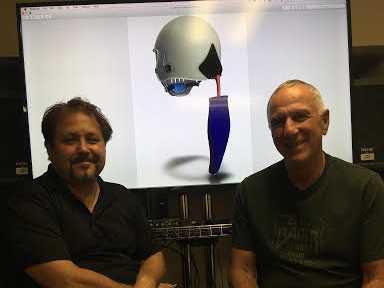When Fred White showed a clip of his son – a football player at Sierra High School – delivering a massive hit in a Thursday night football game to the man responsible for discovering widespread brain damage in football players, the response floored him.
Dr. Bennett Omalu – who discovered chronic traumatic encephalopathy, or CTE in the brains of retired NFL players posthumously – was part of a committee organizing the Not Forgotten Memorial Day event in Manteca when White showed him the clip, and even today he has to hold back tears when recounting the words that the San Joaquin County Medical Examiner delivered to him unflinchingly.
“Mr. White – it is no longer ethical for you to do that to your son,” White recounted, taking a second to compose himself. “That really got me – I didn’t know what to say to that.”
So he went and did something about it.
While Elijah White will suit up and take the field for the Timberwolves tonight as they face the Ripon Indians, his father will be watching knowing that he has come up with a protective system that he believes could revolutionize football and solve many of the safety issues that could lead to long-term cognitive issues down the road.
Enter the Super Personalized Augmented Robotic Exoskeleton, or SPARE.
By utilizing a combination of existing materials and state-of-the-art technology, White – along with business partner Dr. Jim DeCosta, who together have formed A.I. Robotics – has come up with the idea for a helmet and shoulder pad system that would offer an unparalleled level of protection and shock absorption to minimize both rotational injuries to the head, neck and spine as well as brain injuries while offering a data-based system that compiles relevant information on the user.
Based off a 3D-printing model using traditional materials like Kevlar, the SPARE system features a rod that would be mounted to the back of the helmet and connect to a spine that would be mounted to the back of the shoulder pads – calibrated to lock after a certain angle to still allow a full range of motion but prevent full extension of the head, neck or spine. The helmet itself will contain a bladder-like webbing containing non-Newtonian liquid as well as electronic sensors that can read heart rate, temperature, blunt and rotational forces imparted on the person wearing the helmet and then transmitted via Wi-Fi to a station that monitors and compiles the data for future use.
The result of the design creates a relatively seamless appearance into the traditional uniform – with an introduction of a locking ball joint on the back of the helmet and a rod that disappears into the shoulder pads – while offering a completely new approach to the idea of enhancing safety on the field.
And some of the ideas are very futuristic.
As part of the patent paperwork that AI Robotics has submitted, a heads-up display could be incorporated into the helmet to notify the user if the angle of their pursuit is too low – preventing the crown of the helmet from making contact and opening up the user for concussions – and any other relevant information compiled into the software itself.
Had his son not been a football player, White – who considers himself an “innovator” and has come up with products in the past like a groundbreaking 3D printer and a mobile sling to assist people in wheelchair and with mobility issues – said he never would have thought about looking closer at the issues facing those who suit-up today.
“Being a father gave me a different perspective on these issues and the things that impact safety of the players,” White said. “And when you realize that there are lots of other parents out there that want their kids to be as safe as possible, you realize that you’re not alone.”
While the concept is still in its infancy – the corporation is now searching for venture capital to construct a proof of concept and do the necessary relevant testing to prove that construction on a large scale is feasible – they are currently talking with Duke University about submitting the design as part of the HeadHealthTECH Challenges.
The Duke program, which is being run with a multi-million-dollar pledge from the National Football League to create safer helmets, seeks to fund research and designs for safety systems submitted by teams from throughout the world. Both White and DeCosta are also looking at investment opportunities from Silicon Valley Venture Capital firms and technology companies.
Because they’re looking at licensing the technology to equipment manufacturing companies that would utilize their own equipment rather than producing the systems themselves, White believes they will be able to establish more traction and ultimately reach a wider audience.
“This is about safety and literally saving the lives of kids,” White said. “We’ve invested so much in coming up with this, and now it’s just about getting the word out there and trying to get this idea in front of the right person.”
To contact reporter Jason Campbell email jcampbell@mantecabulletin.com or call 209.249.3544.
FATHER USES HIS HEAD
Manteca man helps invent safer football helmet/shoulder pads



